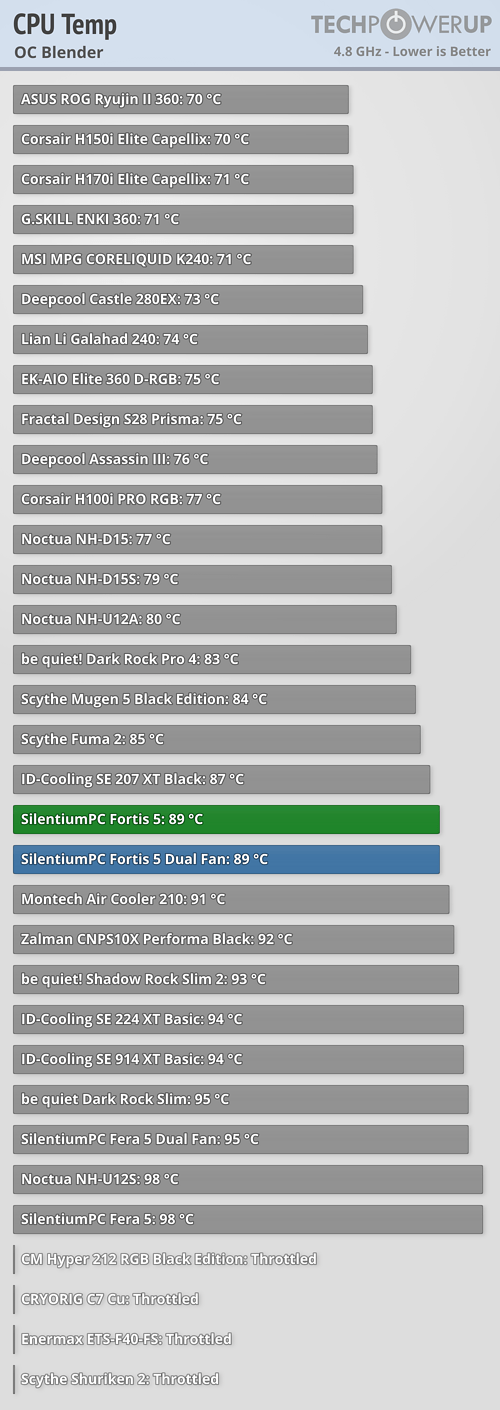 4
4
SilentiumPC Fortis 5 & Fortis 5 Dual Fan Review
Noise Levels & Fan Speeds »Intel Test System and Temperature Results
| Intel Test System | |
|---|---|
| Processor: | Intel Core i9-10900K 4.3 GHz Stock / 4.8 GHz OC |
| Motherboard: | ASUS ROG MAXIMUS XII FORMULA Intel Z490 |
| Memory: | 2x 8 GB Crucial DDR4 3200 CL22 Model: CT2K8G4DFRA32A |
| Graphics Card: | MSI GeForce GTX 1650 Ventus XS OC Edition |
| Storage: | Crucial P2 500 GB M.2 NVMe SSD |
| Power Supply: | Chieftec Chieftronic PowerPlay 850 |
| Case: | Thermaltake Core P3 |
| Operating System: | Windows 10 Professional 64-bit Version 20H2 (October 2020 Update) |
| Thermal Paste: | Arctic MX-5 |
| Other: | Crucial Ballistix 2x 4GB DDR4 2400 Model: BL2K4G24C16U4B (clearance testing only) |
Testing Procedure
On the Intel test platform, we opted for the Core i9-10900K. To find our starting point on the Intel system, we used the Noctua NH-U12S with the fan set to maximum performance. With the stock BIOS, we disabled all multi-core enhancement features and stuck with Intel's specifications. We then used Blender 3D to determine our processor's default all-core clock speed of 4.3 GHz. To ensure testing remains fair on all coolers, we manually applied the CPU's Vcore, which was 1.01 volts, and limited the CPU to the predetermined clock speed. While not an ideal situation, it is the only way to get an apples-to-apples comparison between coolers that is consistent. For overclock testing, the motherboard has MCE enabled, and all limits are removed. We then set the CPU to 4.8 GHz at 1.21 volts. This results in the CPU going from the 125-watt limit defined by Intel all the way up to 200 watts under a sustained heavy load. Again, refer to this articlefor a full breakdown of our testing procedures.The idle test consists of the CPU sitting idle at the desktop for 15 minutes.
The primary load test consists of the Blender BMW render looped for 15 minutes, and the peak temperature is used as the result.
The final test we use is AIDA64's FPU stability test, which offers maximum heat generation. While it is typically considered an unrealistic workload, it is used to show the extra overhead a CPU cooler has available in a worst-case scenario.
All these tests are completed three times for both maximum performance and noise-normalized results.
Idle Temperatures




Typical Load Temperatures




Maximum Load Temperatures




Apr 26th, 2024 12:25 EDT
change timezone
Latest GPU Drivers
New Forum Posts
- checkup (1)
- Help me to OC my 5700X (10)
- XFX RX470 8GB no video and error 43 (28)
- The TPU UK Clubhouse (24788)
- Secure boot already open help (9)
- im new to throttelstop and i think i messed it up by copying others any hints would be very much aprreciated (4)
- Cs2 Freezing in Rx 580 (5)
- Ghost of Tsushima PC Port !!!! (15)
- The Official Linux/Unix Desktop Screenshots Megathread (699)
- Red Dead Redemption using emu (4)
Popular Reviews
- HYTE THICC Q60 240 mm AIO Review
- MOONDROP x Crinacle DUSK In-Ear Monitors Review - The Last 5%
- Alienware Pro Wireless Gaming Keyboard Review
- Upcoming Hardware Launches 2023 (Updated Feb 2024)
- Thermalright Phantom Spirit 120 EVO Review
- FiiO K19 Desktop DAC/Headphone Amplifier Review
- ASUS Radeon RX 7900 GRE TUF OC Review
- RTX 4090 & 53 Games: Ryzen 7 5800X vs Ryzen 7 5800X3D Review
- NVIDIA RTX 4090: 450 W vs 600 W 12VHPWR - Is there any notable performance difference?
- Sapphire Radeon RX 7900 GRE Pulse Review
Controversial News Posts
- Windows 11 Now Officially Adware as Microsoft Embeds Ads in the Start Menu (127)
- Sony PlayStation 5 Pro Specifications Confirmed, Console Arrives Before Holidays (117)
- NVIDIA Points Intel Raptor Lake CPU Users to Get Help from Intel Amid System Instability Issues (106)
- AMD "Strix Halo" Zen 5 Mobile Processor Pictured: Chiplet-based, Uses 256-bit LPDDR5X (101)
- US Government Wants Nuclear Plants to Offload AI Data Center Expansion (98)
- AMD's RDNA 4 GPUs Could Stick with 18 Gbps GDDR6 Memory (92)
- Developers of Outpost Infinity Siege Recommend Underclocking i9-13900K and i9-14900K for Stability on Machines with RTX 4090 (85)
- Windows 10 Security Updates to Cost $61 After 2025, $427 by 2028 (84)